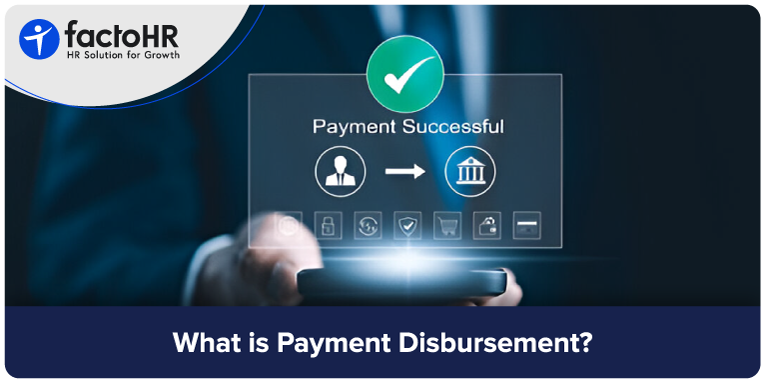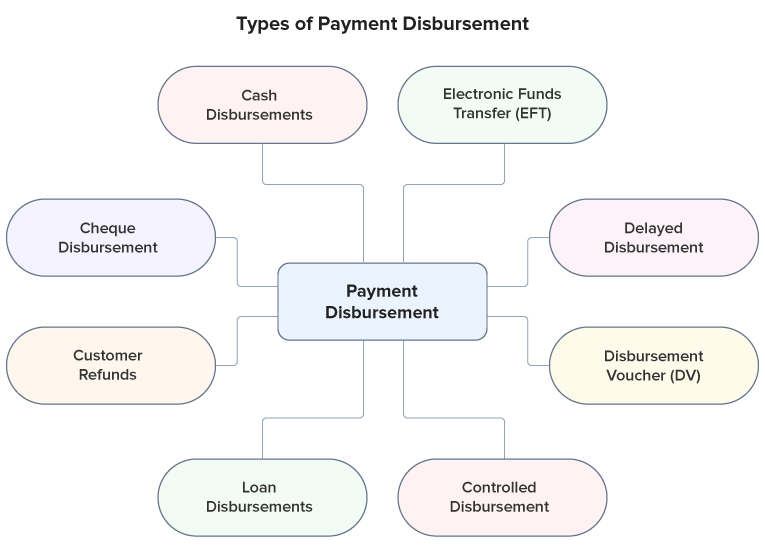What is Payment Disbursement? How It Works, Types & Examples

Table of Contents
What happens to a business when it misses payments to employees or vendors? Can this delay in payment result in damage to the brand’s reputation and increase the risk of legal penalties? Yes, organizations face these challenges regularly. Also, in the traditional method, payroll processes were conducted manually, and there were multiple challenges. These traditional practices include challenges, like compliance risks related to changing labor laws and security concerns due to data breaches. The manual system increased the chances of payroll errors and decreased the business’s overall efficiency.
The advancement in technology allowed businesses to improve their HR processes and solve challenges they faced with traditional payment methods. Organizations can pay their employees and vendors with strong security measures. This article explains how a payment disbursement system works and some common challenges related to it.

What is Payment Disbursement?
Payment disbursement is the process of paying out funds from one entity to another. These include paying salaries to employees and dividends to stakeholders. The process consists of transferring money from the company to a recipient, like an employee or supplier. The process ensures that the payments made are accurate and timely to various entities.
Businesses have a specific fund account to conduct the disbursement process to pay out individuals or other business entities. Organizations choose payment methods like cash or electronic transfer for disbursements. The disbursements are a regular part of any business’s cash flow, and the entries are recorded in journals for future reference. Some of the examples of payment disbursement are:
- Employee Wages or Salaries
- Vendor Payments
- Loan Settlement
- Bill Payments
- Government Expenditures
How does Payment Disbursement work?
There is a structured process for payment disbursement. We have mentioned certain steps that can be followed. These are:
Identification of the Need
The organization identifies a payment that needs to be made, like salary to employees and vendor’s bills. The need for payment is recognized when companies receive invoices or purchase orders.
Authorization
This step is necessary for an organization to avoid legal consequences and contract breaches. When the payment need is identified, the manager authorizes this request obligation. Company policies and internal processes need to be followed during the authorization process.
Verification
This step confirms the accuracy of the payment request made by the opposite party. The documents recorded should be checked properly, and approval given by the authorized departments should be verified. Organizations should ensure that internal guidelines are maintained in compliance with labor laws.
Selecting a Payment Method
There are multiple ways in which a company decides on the payment methods. Some of the payment methods are:
- Cash
- Cheque
- Electronic transfers
- Credit cards
- Other online platforms
Transfer of Funds
The payment is processed once the authorization and verification process is completed. When an organization is paying through cards, this involves send an authorization request to the payment processor. The payment channels are encrypted and have strong security measures to prevent all types of fraud.
Documentation
Documentation is necessary for companies to maintain proper documentation for payroll audit purposes. Details, like recipient details and payment amount, are included in recording. It is maintained for accounting purposes and for transparency.
Payroll Reconciliation
Payroll Reconciliation involves matching two sets of records to ensure they are correct. This step is necessary here because the payer needs to reconcile the payment disbursement to confirm the recording. This means, the internal payment records should be compared with external statements. This step maintains transparency and accuracy, which helps the company stay compliant.

What are the Types of Payment Disbursement?
Companies can choose from various types of payment methods. Below are different types of payment disbursement that businesses might encounter.

Cash Disbursements
Cash disbursement means the physical transfer of cash from one party to another. In traditional methods, cash was one of the immediate and primary modes of payment. Cash payments are now less common for large transactions, but they can be used for disbursing smaller amounts.
Electronic Funds Transfer (EFT)
Electronic Funds Transfer (EFT) is a type of digital payment method that moves money between bank accounts. This method does not involve physical cash or cheques, which is a flexible disbursement method. It includes transactions, like direct deposits of paychecks and automatic bill payments with strong security measures. EFTs reduces processing time while making payments and increases an organization’s overall efficiency.
Delayed Disbursement
Delayed disbursement is a cash management technique that companies use temporarily to increase their cash flow for a short period of time. It is a strategic decision by companies, as they can invest the amount before paying the actual amount. Another reason for delayed disbursement is to earn additional interest on the payer’s account.
Disbursement Voucher (DV)
A disbursement voucher is a document that authorizes and tracks payments made by an organization in situations where it is not directly processed through a purchase order. It is a document that confirms a payment has been made or is about to be made. Payments can be made through various methods, like cheque or electronic transfer.
Controlled Disbursement
Controlled disbursement is a cash management strategy that is used by many businesses to manage their payments. The payer initiates the payment, which the bank verifies and then approves before disbursing. This method proves to be a more controlled way of managing payments for any company and also helps prevent fraud.
Loan Disbursements
Loan disbursements mean transferring money to a borrower’s account for the specific loan amount that is approved. Sometimes, when businesses have taken out a loan, this amount is settled as a loan disbursement.
Customer Refunds
Customer refunds refer to the process of returning money to a customer after a transaction is reversed or cancelled. Product returns and unsatisfactory customer service can be some of the reasons why this situation arises. It is important to manage customer relations to build customer trust and enhance customer satisfaction.
Cheque Disbursement
A cheque disbursement refers to a physical or electronic cheque payment that is used to transfer funds from one party to another. This mode of payment is a standard method for businesses to pay their suppliers or employees.

What are the Challenges in Payment Disbursement?
Many businesses have a formal and straightforward method for payment disbursement. But sometimes they go through some common challenges during the process. These are:
Fraud Risks
Risk of fraud is one of the most common challenges that businesses face. Some of these fraudulent activities lead to financial losses and damage to the brand’s reputation. Frauds in payment disbursement can take place in the form of fake invoices or expense reimbursement schemes. Also, the process of identifying fraud can be made difficult by scammers, as they can use complex techniques. These fraud incidents can lead to a decrease in consumer trust and a reduction in business activity.
Technological advancement has allowed companies to make use of new tools and techniques. They can ensure strong security measures and prevent any kinds of fraud. While developing a payment disbursement strategy, the decisions should be comply with security and fraud prevention laws.
Compliance Issues
Organizations must stay compliant with industry-specific laws to make sure that payments are processed securely and legally. There are some regulatory requirements, like anti-money laundering (AML) laws and tax compliance, that organizations should maintain. Compliance issues are faced when organizations have incomplete or inaccurate records, which can lead to delayed payments. Businesses should maintain documentation of various invoices and contracts that are necessary by law.
In addition to this, weak internal controls can lead to fraudulent and unauthorized payments, which can sometimes lead to data breaches. Businesses need to focus on updating themselves with laws, when it comes to tax laws and reporting standards.
Operational Delays
Companies face operational delays that affect their cash flows and other inefficiencies. Operational delays are caused by system interruptions or software glitches, which prevent real-time processing of payments. Some of the outdated payroll software can also lead to compliance issues and other payroll errors.
Data inconsistency and a lack of payroll automation can also lead to delays in payment disbursement. Errors in manual entries and a lack of up-to-date information can cause incorrect payments and further delays. Operational delays can cause disruption in cash flow and affect the business’s ability to pay other entities.
Cash Flow Management
Cash flow, when not managed effectively, can lead to multiple issues for any organization. It’s not necessary that companies receive revenue at regular intervals, which can make it difficult for them to predict their cash flows. Some unpredictable expenses can also lead to depletion of cash reserves and delays in paying the company’s creditors. Some market changes, like economic downturns or recessions, can affect a business’s operational performance.

Conclusion
Payment disbursement is one of the most important aspects when managing payroll metrics and other business expenses. There is a need for organizations to track their payments and maintain accurate documentation to help avoid any inconsistencies in operations. Disbursement processes should be maintained for the organization’s financial health and operational stability. A structured process helps minimize errors and fraud, as the approval workflows are strong. It also helps maintain compliance with laws because all payments made are authorized and documented.
factoHR’s payroll software allows businesses to automate some of the administrative payroll-related tasks and integrate with third-party applications easily. It can make disbursement management more effective and enhance the overall organizational financial health.
What is an example of a Payroll Disbursement?
Some examples of a payment disbursement are:
- Vendor Payments
- Rent Payments
- Charitable Contributions
- Utility Payments
- Tax Payments
- Employee Expense Reimbursement
- Paying Employee Salaries
What is the process of Payment Disbursement?
A payment disbursement is a structured process, and it includes the following steps:
- Initiation of Payment Request
- Authorization and Approval
- Selection of Payment Method
- Processing the Payment
- Record-Keeping and Accounting
- Reconciliation and Reporting
How long does the disbursement process take?
The disbursement process can take one to five business days. In case of cheque payment, the bank can take three days to transfer money from one bank account to another. There are some factors, like the type of disbursement and the lender’s company policies, that influence the number of days in the disbursement process.
Grow your business with factoHR today
Focus on the significant decision-making tasks, transfer all your common repetitive HR tasks to factoHR and see the things falling into their place.

© 2026 Copyright factoHR


